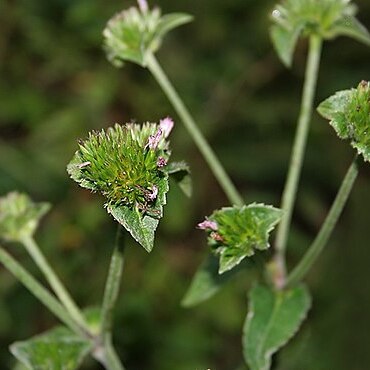Herbs, perennial, 20-60 cm tall. Rhizomes procumbent or obliquely ascending, with many fibrous roots. Stems erect, ± dichotomously branched, slightly scabrid, densely white adpressed hirsute. Basal leaves persistent by anthesis, rosulate, spatulate or oblanceolate, 5-18 × 2-4 cm, abaxially densely hirsute and glandular, adaxially sparsely hirsute, base gradually attenuate into short, broad petiole, margin crenate-serrate, apex rounded or shortly acute; cauline leaves few and small, oblanceolate or oblong-lanceolate, progressively smaller toward apex. Synflorescence densely aggregated in compound heads, surrounded by leaflike bracts; bracts broadly ovate or oblong-ovate, 1-1.5 × 0.5-1 cm, hirsute and glandular, with conspicuously raised veins, apex acuminate. Capitula many. Involucre narrow, 8-10 × ca. 2 mm; phyllaries green or apically purple-red, oblong-lanceolate, hirtellous and glandular, 1-or 3-veined, apex acuminate and spinescent, outer 4-5 mm, inner ca. 10 mm. Florets 4, herbaceous, purplish or pink; corolla 7-9 mm, tube 4-5 mm. Achenes oblong-linear, ca. 4 mm, angled, puberulent. Pappus sordid white, of 5(or 6) basally widened bristles, 4-5 mm. Fl. Jul-Nov. 2n = 22*.
Erect herbs, 30–60 (–100) cm high, with annual, usually dichotomously branched, densely hirsute stems from woody rootstock. Leaves usually in basal rosette, narrowly oblanceolate or ovate-elliptic to spathulate, (5–) 6–18 (–20) cm long, (1.5) 3–10 cm wide, long attenuate to petiole, semiamplexicaul to sheathing at base, entire or occasionally serrulate-crenulate, bristly-hairy to scabrid; cauline leaves much smaller, sessile and amplexicaul. Capitular glomerules 1.2–2 cm diam., each subtended by 3–5 ovate, leaf-like bracts. Involucral bracts oblong-lanceolate; outer bracts c. 3.5–4.5 mm long; inner bracts c. twice as long as outer, apically cartilaginous, pungent. Florets mauve or purple; corolla (4.5–) 5–7 mm long; lobes apically glandular. Achenes narrowly turbinate-cylindric, 3–4 mm long; ribs setulose. Pappus bristles 5 or 6, stiff, 4.5–5.5 mm long, apically setaceous, dirty-white.
A small herb plant which keeps growing from year to year. It is 30-100 cm high and spreads to 30-60 cm across. It has a creeping rootstock. The stem is stiff and erect. 1-3 stems arise from the base. The stem is densely hairy and warty and is white. The leaves are 10-40 cm long by 1-6 cm wide and oblong. The leaves have a notched edge. The leaves are arranged in a circle near the base. They do not have leaf stalks. There are also some leaves along the stem. These are smaller. The flowers are in compound heads and are yellow or blue. They have leaf like bracts around them. The heads are 2.5 cm across with 20-50 flowers.
Basal leaves mostly 7–62 x 1.5–10 cm., narrowly oblanceolate or ovate-elliptic, subacute or rounded at the apex, narrowly cuneate to long-attenuate below with the midrib becoming very narrowly winged or petiole-like, the base ± stem-clasping or shortly stem-sheathing, margins entire or sometimes serrulate-crenulate, lamina somewhat scabridulous to glabrescent with scattered patent 1–2 mm. long bristle-like hairs; cauline leaves 1–5, smaller than the basal leaves, sessile and ± stem-clasping, grading into ± conduplicate synflorescence bracts.
Capitula sessile, crowded in glomerules 1.2–3 cm. in diam.; glomerules terminal on few-many stiff synflorescence branches 3–11 cm. long, or sometimes several glomerules ± scorpioidly arranged along a branch, glomerule-subtending bracts 3–5, ovate, leaf-like, ± equalling the glomerules in length.
Phyllaries usually 2-seriate with c. 4 phyllaries in each series, oblong-lanceolate, cartilaginous with pungent apices and membranous margins, strigose or ± densely hispid where exposed, or glabrous; the inner phyllaries 7–9 mm. long, nearly twice as long as the outer.
Achenes 3–4 mm. long, narrowly turbinate-cylindric, c. 10-ribbed, setulose mainly on the ribs; pappus of 7–10 elements 3.5–6 mm. long, overlapping scale-like below and gradually tapering into a subterete barbellate seta.
Corollas mauve, 4.5–7 mm. long, narrowly funnel-shaped, 5-lobed but more deeply cleft down one side, glandular at the lobe apices otherwise glabrous.
An erect tough hirsute perennial herb to c. 130 cm. tall, with scapiform annual stems from a woody rootstock; roots numerous, thong-like.
Stems 1-several, branching above, leafy below, densely hirsute, or ± strigose on upper stem and branches.
Involucres 7–10 x 2–3 mm., narrowly ovoid-cylindric.
Florets c. 4 per capitulum.

